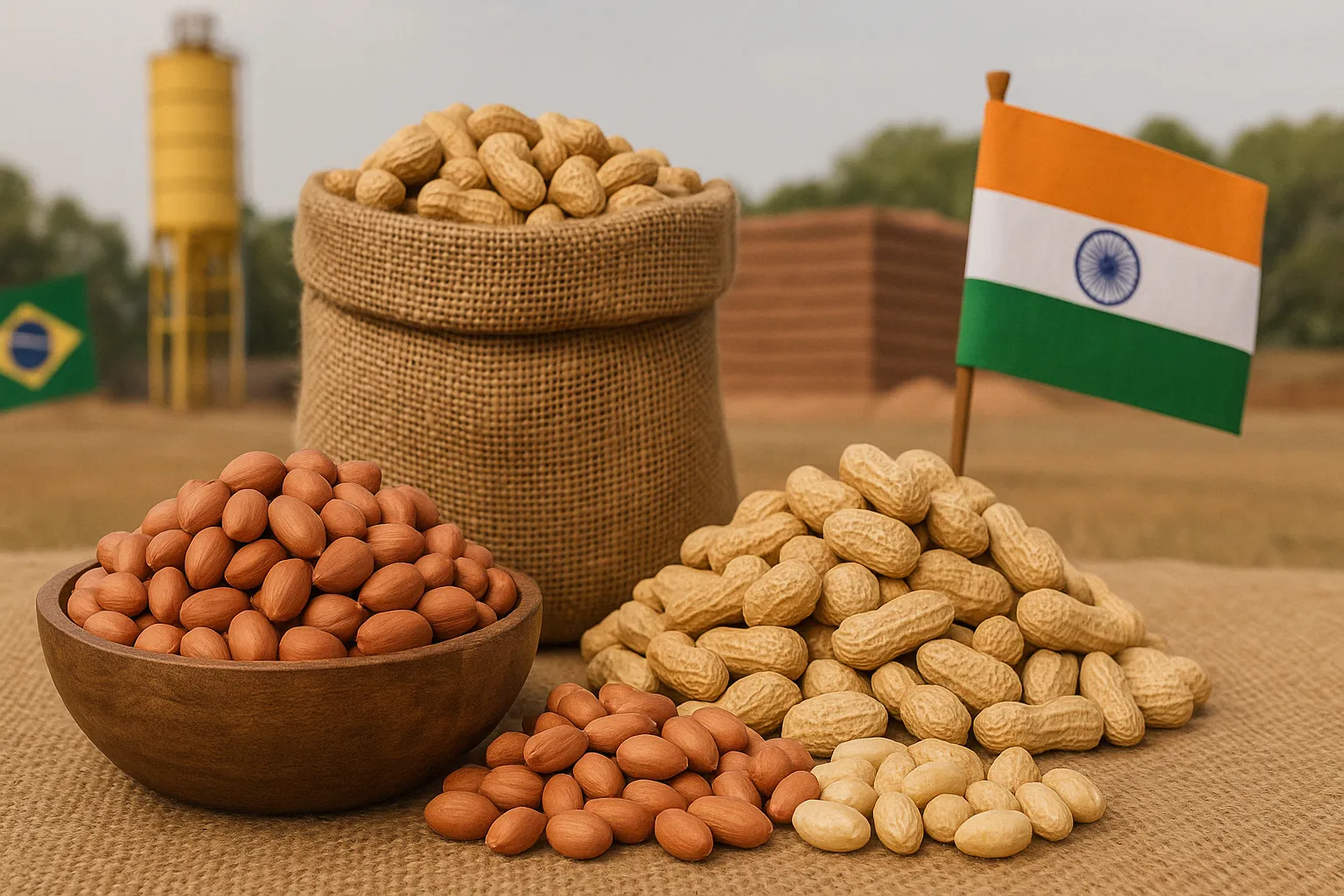Brazil Takes China by Storm: Inside India’s Government Stock Dump and Reshaping Peanut Market Worldwide!
In April 2025, the global peanut market finds itself at a dynamic crossroads. Industry stakeholders contend with shifting government policies, delayed harvests in key regions, and international tariff uncertainties—especially stemming from U.S. President Trump’s evolving tariff mandates. Below is a comprehensive, humanized analysis of the current peanut market landscape, highlighting production status, export/import directions, quality and price trends, and the reasons behind them. In addition, we will explore the pivotal role of tariffs and how these measures are reshaping global peanut trade. Finally, we’ll incorporate any additional or complementary updates that were not covered in the main sections.

1. Latest Market Updates & News
- Steady Yet Fragile Indian Peanut Prices
- April 14, 2025: Indian peanut prices remain stable at levels similar to those seen a week ago, but many market analysts predict a near-future dip. Wholesale demand traditionally softens heading into the hot summer months.
- Gujarat Government Stock Releases: The Gujarat state government, holding an estimated 1.3 million MT of peanuts, has commenced a series of auctions at favorable rates. This government supply effectively dampens local traders’ willingness to purchase from farmers at higher prices.
- Trader Sentiment: A climate of caution has taken hold. Some anticipate that if government tender prices are set too low, private sector purchasing could temporarily freeze or pivot to waiting for cheaper government stocks.
- Brazil Emerges as a Key Supplier to China
- March 31, 2025: Brazil’s peanut industry has rapidly gained traction in China due to supply disruptions from Sudan, combined with renewed trade tension between the United States and China. With Sudan facing difficulties (political and logistic disruptions), Chinese buyers view Brazil as an increasingly reliable partner.
- Harvest Update: South American harvests are concluding, with yields in Brazil generally good. Exporters report stable to slightly elevated kernel quality.
- U.S. Tariff Environment Creates Uncertainty
- 10% Baseline + Additional Tariffs: From April 2 onward, all imports into the United States face a baseline 10% tariff. Meanwhile, further tariffs—some as high as 46% on specific goods from Vietnam—have unsettled peanut exporters globally.
- Effect on U.S. Demand: Many global producers remain confused, causing transaction disruptions. Demand for U.S. peanuts has notably dipped; even domestic shellers worry that large importers of finished peanut products might shift to alternative suppliers if tariff escalations continue.
- Indian Exporters Walking a Fine Line
- April 7, 2025: Price declines of around USD 10/MT in Indian peanuts have narrowed trading ranges. However, exporters watch carefully: farmers and traders alike worry about new U.S. and Chinese restrictions, which can skew global demand and hamper Indian shipments.
- Volatile Government Statements
- Fake News Episode: In late March, a false news article spread panic in India by claiming the Gujarat government would accept extremely low prices (USD 52.5–59.0 per quintal). This caused an abrupt stall in deals until the government clarified it was not the case, highlighting how rumors can instantly chill market activity.

2. Global Production Status & Harvest Quality
India
- Reduced Sowing & Delays: India’s summer peanut crop dropped significantly, in some states by nearly 50% compared to a seven-year average. Gujarat, Maharashtra, West Bengal, and Uttar Pradesh all report harvests at only 40–50% of last year’s levels.
- Quality & Harvest Timing: Despite robust attempts at pest control, unseasonal rains and temperature swings have impacted yields and kernel quality. The result: a smaller, although generally decent, harvest.
- Government Influence: The Gujarat authorities’ policy of stocking and then auctioning peanuts influences local pricing. If they pause stock sales or set minimal bidding too high, prices could jump by USD 20–30/MT.
Brazil
- Harvest Concludes: Brazil’s peanut harvest is winding down with moderate to good yields. According to local processors, export volumes to China and Asia are increasing, in part due to logistic and political issues limiting Sudan’s performance.
- Quality Outlook: Brazilian peanuts entering the market score well in flavor and oil content. Some shipments also target new destinations, e.g., the Middle East.
Argentina
- Recovery from Past Setbacks: Argentina saw a strong bounce in 2023–2024, with Córdoba leading a 64% year-on-year increase. In 2024–2025, producers forecast a more modest yield amid stable acreage.
Other Regions
- Bangladesh: Farmers expand peanut acreage fueled by rising local demand for peanut-based edible oils and feed.
- Africa: Sudan’s supply disruptions (economic and political turmoil) direct more of the Chinese, MENA, and Southeast Asian markets to alternative origins (Brazil, India, potentially Tanzania).
- China: Domestic peanut planting remains robust, but overshadowed by ongoing or threatened U.S. tariffs. In 2024, Chinese peanut imports from the U.S. fell, replaced by Brazilian nuts.

3. Major Exporters & Importers
- India
- Exports: India’s shipments remain somewhat subdued. Price volatility at home and a cautious global environment—especially with the shifting U.S. tariff scenario—keeps deals cautious.
- Domestic Impact: The Gujarat government’s timely auctions overshadow private buying.
- Brazil
- Exports: Gains momentum as it capitalizes on demand from China, especially with Sudan’s issues and increased reliability from the Brazilian side. Shipping lines remain consistent, with potential expansion into the Middle East.
- United States
- Uncertainty: Domestic shellers face uncertainties with the newly imposed 10% baseline tariff and possible retaliation from Canada, Mexico, and China. Peanuts were singled out in certain U.S. policy statements but not yet hammered with the highest rates.
- International Reaction: Some major importers signal they might reduce reliance on U.S. peanuts, seeking alternative or cheaper suppliers if Trump’s additional levies disrupt normal price competitiveness.
- China
- Imports: Import volume from the U.S. decreased, while purchases from Brazil soared. Domestic consumption remains high, and shortfalls in local production see the country diversify supply sources.

4. Prices, Present Trends & Future Signals
Current Price Levels
- India: Peanuts (~1.10 €/kg) remain stable for top-grade (Java, Bold varieties). Some local quotes are in the USD 1,000–1,030/MT range for 50/60 count. Government tender-based peanuts often move slightly below open market rates.
- Brazil: A moderate increase at 1.74 €/kg, reflecting strong Chinese buying.
- China: Blanched peanuts at 1.39 €/kg, down 1.9%—due to stable domestic supply and an attempt to remain price-competitive under uncertain global trade.
Market Analysis & Signals
- Supply & Demand Balance: Summer sowing shortfalls in India imply restricted availability mid-year, likely preventing a major price crash. Nonetheless, government auctions hamper significant price runs.
- Exporter Strategies: Some Indian exporters shift focus to Middle East markets (e.g., Saudi Arabia, UAE) to offset potential slowdown in U.S. or EU trade. Brazil intensifies ties with China.
- Seasonal Doldrums: With Ramadan concluding and warmer months approaching, wholesale purchase volumes typically shrink, further constraining price surges.

5. Tariffs: Effects on the Global Peanut Trade
Trump’s Tariff Web
- Baseline 10% from April 2, 2025, on all U.S. imports—and ad-hoc higher rates on certain countries’ peanuts. Though peanuts have not been singled out for the highest bracket, rumor or partial references mention a potential 2.5–3% surcharge beyond the baseline for certain peanut varieties.
- Retaliation & Confusion: Canada and Mexico keep an eye on possible reaction, but peanuts are not a top item in their retaliation lists. Meanwhile, China’s extended trade war with the U.S. dampens U.S. peanut prospects, opening the door for Brazilian and African suppliers.
India–U.S. Tariff Ties
- No immediate direct peanut tariff controversies, but broader negotiations around agricultural goods could pivot. Indian exporters, however, remain watchful in case the U.S. lumps peanuts under a bigger tariff bracket to pressure Indian policymakers.
EU’s Stand
- Not as peanut-centric as with nuts like almonds. However, any expansion of the EU’s retaliatory list might affect U.S. peanut or peanut butter flows, though it’s not their main confrontation product.
6. Outlook: Upcoming Months & Strategies
- Short-Term Prospects
- Indian peanut prices likely to soften modestly; high government stock presence + lower seasonal demand hamper a big rally. Traders may selectively buy at dips.
- Brazil’s export impetus remains robust, especially if China continues to avoid U.S. origins.
- U.S. producers face continued uncertainties around Trump’s tariff see-saw, raising anxieties about losing overseas market share.
- Medium-Term (Post-June/July)
- Indian summer peanut arrivals might be smaller, supporting local prices to bounce back if government auctions slow.
- If the U.S. escalates or modifies existing tariffs, global flows could shift more substantially.
- Growing financial pressures on smaller Indian farmers could provoke requests for more direct government procurement at minimum support prices (MSP).
- Advice for Market Participants
- Importers: Diversify origins—Brazil, India, Argentina, possibly African countries—for risk management. Monitor any tariff modifications on peanuts specifically.
- Exporters (India): Keep close track of government tender announcements. Long-term forward contracts may hedge against unexpected price dips.
- Producers: Watch out for unseasonal rain forecasts; plan storage strategies if government auctions oversaturate the local market, compressing farmgate prices.

7. Additional & Complementary Updates
- Argentine Recovery: Argentina, after a strong 2024/25 peanut surge (+64% yoy in top region Córdoba), is pushing to maintain that momentum. Export volumes, up by +13% yoy, may catch Chinese interest should Brazilian supply tighten or logistic disruptions arise.
- Fake News Panic: The misreport in India’s Gujarat in late March illustrated how swiftly a rumor can crash local markets. It underscores the need for official government clarity on tender prices to prevent damaging speculation.
- Tanzania Potential: Although overshadowed by its robust cashew sector, Tanzania also cultivates peanuts. Some Chinese importers have begun test shipments from Tanzania as a risk-hedge against any abrupt Indian price hikes or logistic slowdowns.
- Bangladesh Growth: Farmers are expanding peanut cultivation for edible oil and feed markets. Although not a global export competitor yet, Bangladesh’s local peanut output is fueling domestic edible oil blending. Future surplus could set the stage for small export pockets.
- Weather in Southeastern Africa: Some speculation about a mild El Niño later this year, which could hamper rain patterns for certain African peanut producers. This scenario might come into play for late 2025.
Final Note
In sum, April 2025 finds peanuts in a delicate equilibrium. India’s stable but threatened prices—and its robust government stock sales—coincide with Brazilian export success and U.S. tariff chaos. Producers, exporters, and buyers all navigate uncertain waters, aided by steady though unspectacular demand. Key watchers revolve around government auctions, sowing yields, and Trump’s next tariff move. Despite potential short-term softness in India, the mid-year outlook suggests that if harvest shortfalls and tariff twists align, price rebounds could surface. The global peanut trade, while overshadowed by more volatile markets like almonds, remains a staple commodity requiring persistent vigilance and strategic hedging.
Frequently Asked Questions About the 2025 Global Peanut Market
1. Why are Indian peanut prices expected to soften in mid‑2025?
Indian prices are under pressure because the Gujarat state government is auctioning roughly 1.3 million MT of carry‑over stocks at attractive reserve rates. Combined with lower seasonal demand during the hot summer months, this extra supply is likely to push farm‑gate and export prices slightly lower.
2. How will U.S. baseline tariffs of 10 % impact global peanut trade?
The blanket 10 % import tariff that began on 2 April 2025 increases landed costs for every origin shipping to the United States. While peanuts were spared the highest “reciprocal” rates, even a modest surcharge can steer price‑sensitive snack makers and peanut‑butter processors toward cheaper domestic or Latin‑American supply.
3. Which country is gaining the most from China’s shift away from U.S. peanuts?
Brazil is the clear winner. Reliable harvests, competitive FOB values, and Sudan’s logistical problems have allowed Brazilian exporters to grab additional Chinese market share throughout Q1–Q2 2025.
4. Will Brazil have enough crop to satisfy booming Chinese demand?
Yes—South‑American harvests are finishing with solid yields. Exporters report good kernel quality and ample volumes for forward shipment, making Brazil a dependable partner for Chinese buyers through the 2025/26 cycle.
5. How does Gujarat’s tender policy influence international peanut prices?
Because Gujarat is India’s largest peanut‑producing state, its minimum tender bid effectively becomes an unofficial price floor for Java and Bold varieties. When the state raises or pauses tenders, private exporters adjust offers upward; when it sells aggressively, global prices ease.
6. Are peanut supplies really tight in 2025?
Globally, production is relatively balanced, but regional shortages exist. India’s summer crop is down as much as 50 % in some districts, and delayed sowing will keep local inventories thin until the next harvest in June/July. That tightness can offset bearish pressure from government auctions.
7. What quality issues should buyers watch for this season?
Unseasonal rains in western India and sporadic heat stress in South America can raise aflatoxin and mold risk. Buyers should insist on third‑party lab certificates—especially for large‑count kernels and blanched shipments—to avoid compliance problems in the EU, China, or the U.S.
8. When will new‑crop Indian peanuts enter the market?
Early summer plantings in Gujarat, Maharashtra, and Banaskantha should reach markets by late June or early July, weather permitting. Traders expect the first sizeable arrivals to coincide with the end of government stock auctions.
9. How can importers hedge against tariff volatility?
Diversify origins—Brazil, Argentina, India, Tanzania—and lock in freight early. Many shippers are offering optional‑origin contracts that allow a switch if tariffs shift before shipment.
10. What is the short‑term price outlook for peanuts through Q3 2025?
Most analysts foresee a stable‑to‑soft bias until late June, followed by mild upside risk if Indian new‑crop yields disappoint or if U.S. tariffs escalate further. Monitoring Gujarat tender announcements and Chinese buying pace will give the clearest clues.









